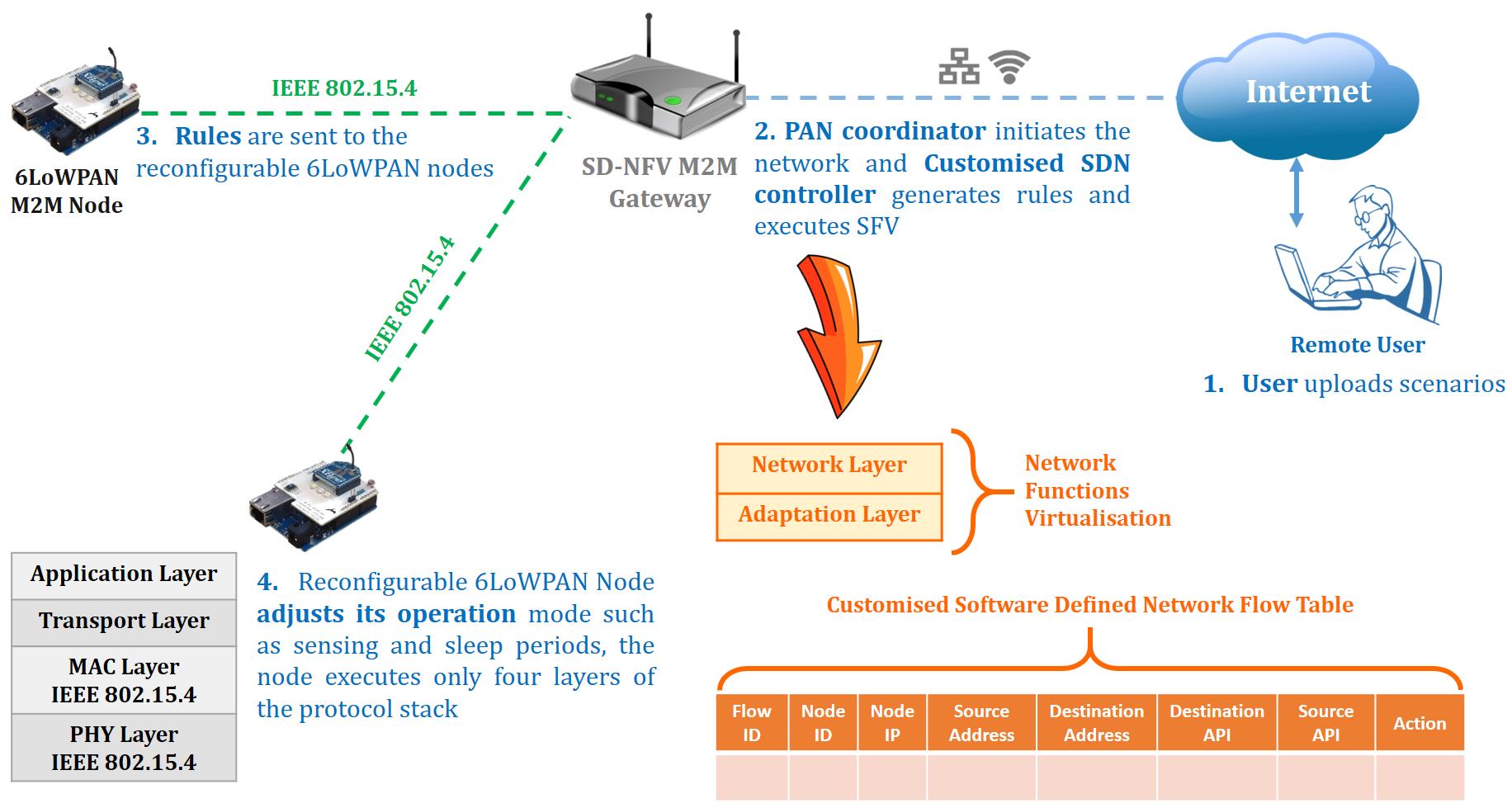PhD Research Title:

This research focuses on optimising 6LoWPAN network parameters to reduce the energy consumption and latency in cluster-based M2M sensor networks, using Software-Defined Networking (SDN) and Network Functioning Virtualisation (NFV) technologies.
Using SDN and NFV in Cloud-based 6LoWPAN Networks as an Energy-Efficient Approach for IoT Environment
Recently, SDN and NFV are being used in M2M sensor networks to add programmability and flexibility features in order to adopt the exponential increment in wireless M2M traffic and enable network configuration even after deployment. The M2M gateway is connected to a cloud computing platform and runs the 6LoWPAN protocol stack. The proposed approach takes the advantage of SDN and NFV paradigms in separating the control plane from the data plane in 6LoWPAN nodes and running the software components on centralised M2M gateway connected to the cloud. The developed approach is called customised Software Defined–Network Functioning Virtualisation (SD–NFV), which is validated through mathematical and experimental analysis using real-time 6LoWPAN testbed. The proof-of-concept testbed relies upon open-source hardware and software platforms to build cost-effective M2M sensor nodes. The obtained results show that the developed SD-NFV gateway reduces the end-to-end delay by approximately 23% and 15% compared to traditional (non SDN-enabled) gateway in terms of data gathering and control message propagation respectively. The obtained results also show that the SD-NFV approach prolongs the sensor node lifetime by 65% in comparison to the traditional 6LoWPAN network.
In summary, the proposed SD–NFV approach is quite suitable for constrained networks where energy and processing efficiency are the major concerns. Furthermore, the SD–NFV gateway improves network programmability, simplicity, and management and its architecture is depicted in Figure 1.
 Figure 1: The proposed architecture of the SD–NFV gateway using cloud–based 6LoWPAN testbed
Figure 1: The proposed architecture of the SD–NFV gateway using cloud–based 6LoWPAN testbed
Journal Publications
- B. R. Al-Kaseem and H. S. Al-Raweshidy, "SD-NFV as an Energy Efficient Approach for M2M Networks Using Cloud-Based 6LoWPAN Testbed," in IEEE Internet of Things Journal, vol. PP, no. 99, pp.1-1.
Conference Publications
- Bilal Al-Kaseem, “Modelling of Sustainable 6LoWPAN Sensor Node for Smart IoT Applications”, in Brunel Poster Conference 2017, Brunel University London, United Kingdom, July 2017.
- B. R. Al-Kaseem and H. S. Al-Raweshidy, "Energy Efficient MAC Protocol with Smart Sleep Scheduling for Cluster-Based M2M Networks," 2016 6th International Conference on Information Communication and Management (ICICM), Hatfield, Oct. 2016, pp. 227-232.
- B. R. Al-Kaseem, A. O. Nyanteh and H. S. Al-Raweshidy, "Self-Organized Clustering Technique Based on Sink Mobility in Heterogeneous M2M Sensor Networks," 2016 International Conference for Students on Applied Engineering (ICSAE), Newcastle upon Tyne, Oct. 2016, pp. 431-436.
- B. R. Al-Kaseem and H. S. Al-Raweshidy, "Enabling Wireless Software Defined Networking in Cloud Based Machine-to-Machine Gateway," 2016 8th Computer Science and Electronic Engineering (CEEC), Colchester, Sept. 2016, pp. 24-29.
- B. R. Al-Kaseem and H. S. Al-Raweshidy, "Scalable M2M Routing Protocol for Energy Efficient IoT Wireless Applications," 2016 8th Computer Science and Electronic Engineering (CEEC), Colchester, Sept. 2016, pp. 30-35.
- Bilal Al-Kaseem, “Cognitive and Reconfigurable 6LoWPAN SDN Routing Protocol”, in 2014 Research Student Conference (ResCon14), Brunel University London, United Kingdom, June 2014.